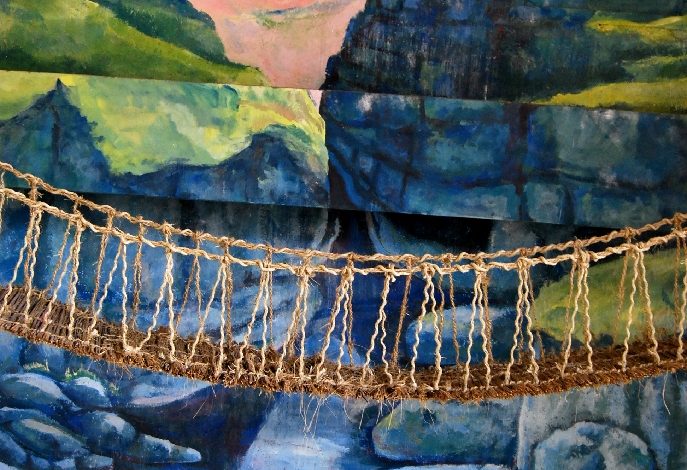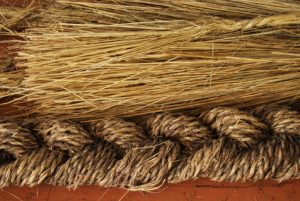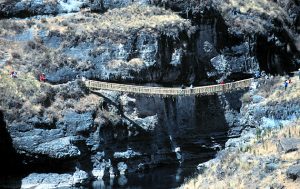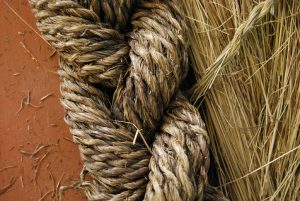
Considered by locals “The Incan Bridge”, Q’eswachaca is one of the hanging bridges of the great road system that once tied the Inca Empire together. While, after the Spanish invasion, most of those bridges disappeared, this bridge continues and is continually kept up thanks to the ability and knowledge of local residents, skills and knowledge they inherited from our ancestors. The well-trained villagers renew the bridge every year. Thanks to their commitment, the bridge has not disappeared but continues in use.
Some people claim the emperors Pachacutec and Mayta Capac ordered the bridge built in order to expand the empire.
The bridge’s name is composed of two Quechua words: q’eswa which means ropes of twisted straw and chaca, meaning bridge. The local community members gather straw and twine the various sizes of ropes to keep the bridge going such that the bridge reflects not only nature, but the spirit of communal work.
It is 27 meters long and crosses the gorge over the Apurimac river at a height of approximately 16 meters. Located strategically between the communities of Chaupibamda, Huinchiri, Qowana Qewe y Opercaro, the bridge forms part of the province of Canas of the Department of Cuzco, on the road that goes to the region of Apurimac.
In June the communities on either side of the gorge enter into a festive state of communal work, called minka. Men, women, and children work together in harmony to rebuild the bridge. They do it when the rains have ceased and only the cold wind blows against the ichu grass, also known as “strong straw”, paja brava, drying it and preparing it for use. In the mornings of June at this altitude the dry stalks of grass are covered each morning in frost due to the heavy freezes typical of June.

Around the bridge you can see an almost magical environment. To begin the very important ritual of working together the people first make a payment to the Mother Earth, the Pachamama. They invoke the Apus, the high mountain lords Huaytamuyu and Quinsañawi so that during the three days of labor they will join the people and permit a new bridge to be successfully constructed without any accidents.

On the first day of work, from an early hour, the population of the communities goes out to cut the right ind of straw, called Qoya Ichu. It is a special kind of ichu, or tough bunch grass, that only grows in the high Andes. Then they pound the bundles of straw with stones to make the more flexible and they selectively add moisture to make it more resistant.
Even though the men also have the knowledge of how to do this process, the women have the charge of twining the ropes from the straw. They weave thin ropes called zoguillas in Spanish and Q’eswakuna in Quechua. Rapidly a quantity of rope appears from the very skilled hands of the women. This work is not performed in a casual fashion. The representatives of the four communities come together and decide on a work plan, a budget, and finally a census of everyone. Then they form small teams who are responsible for every task. People carry out the tasks with pleasure, everyone working together just as they always did in Inca times.
Together they weave about 25 thousand meters of small ropes. The different groups work them and then turn them over in bundles to the leaders. Once all the little ropes are ready, by afternoon, the men stretch out on either side of the highway 22 small ropes that they combine and twist under pressure to make q’eswasqakuna. These are thick ropes, about the thickness of a man’s arm. Some men pull the rope to the left and others to the right. Everyone is happy and proud, without any doubt, They consider the qoya ichu, the straw, a gift of the Earth Mother. They also consider the means of working the straw together a major inheritance from our ancestors, the Incas. They have relied on this heritage in which the men come together to multiply their strength by working in a group for centuries.

Then they twist two q’eswasqakuna for the hand rails and they begin making even thicker ropes with three q’eswasqakuna. Four of these thick ropes form the floor of the bridge. As the late afternoon arrives they carry the rope to the bridge posts and thus finish their first day of hard, yet festive, work.
Very early the next day, in the midst of an intense cold, they begin their day with a “payment” (offering) to the Mother Earth, the Pachamama. They will continue making these offerings until they finish with the reconstruction of the bridge.
This second day is much calmer; there is not as much festive noise as in the first day. You can only see the men working today, the women do not work. They say that would be bad luck, qencha, as they call it. Many of the men come to work in their traditional costume, jackets and pants of a white, hand-woven, wool cloth called bayeta, which they weave for themselves.
To begin the work, the rope is extended from one side of the gorge to the other. Even though it is not part of the work, per se, it allows them to exchange things that are a necessary part of the work, coca leaves among them. On this day the old bridge will be cut down. The most skilled men begin to untie the old ropes while they stretch out, one by one, the new ropes.
Four supports grounded in living rock are there. According to the people of the area they have been there from Inca times. On both sides a large part of the population works to temper the ropes and tie them to the supports. First they form the floor and then the renewed bridge takes shape. They pound the old bridge harder and harder and little by little it begins to fall.
While this work takes place the women and children begin arriving and observe the process from a distance. They know they are not allowed to come close to the work zone.
When the moment comes that the old bridge falls slowly away, the people’s mood shifts dramatically. Now they begin working with much more energy and enthusiasm.
When it is time to take a break, the master bridge builders, their helpers, and the shamans gather to converse and to share food and coca with each other. The other people gather in families and also share food. After their lunch the work continues. The ropes are put in place and all the connections, as well as their tension, are checked. And, with that effort the second day ends.
On the third day, the villages are deserted because from a very early hour all the people go down to the work site to see the finishing of the new bridge. Groups of women and children located themselves on the sides of the hills, dressed in their colorful skirts and hats, made in different styles and materials.
Other community members come to the construction site bringing dry poles and from rich they stretch the bridge’s floor to conclude the construction. Other people prepare smaller ropes to put together the bridge’s sides which they begin carrying out from both sides simultaneously.

The master begins weaving the floor and a primary helper, who is by tradition his son, weaves the main ropes that serve as rails to sustain the sides. Two more people keep them well supplied with smaller ropes from which to make their parts. The master rope makers and their closest helpers are from the community of Huinchiri. Both the father and so work together with precision and speed.
Their work flows naturally. They lay the woven mats down for the floor, while the shamans continue thanking the Apus, the tutelary mountains which always protect the communities. When the work comes to an end, everyone is fascinated to observe the new bridge.
Now they just have to test it. Many would like to be the first to cross but the godparents, the sponsors of the work parties, the authorities, and special guests are the first. Then the bridge is handed over to its “owners”, the community members. As night arrives the people return home, each person content for having participated in this event. The master bridge makers now will celebrate what they have seen and felt. And, they begin to wait for the next year to ratify one more time their knowledge and their position of respect and leadership in the communities.
Q’eswachaca, as you can tell, is much more than simply a technology, or simply a bridge. It is that and engineering, a culture, harmony, and a protection of nature. It makes sense that the National Institute of Culture would have declared the bridge making as part of the National Patrimony. This is our Peruvian heritage too.




